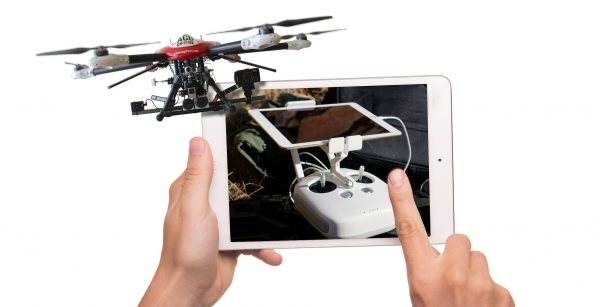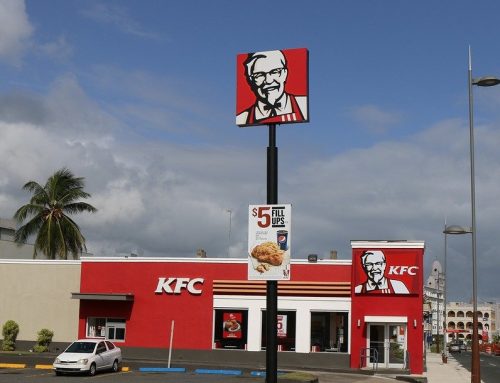Wie Sie einen Einstieg in das 3D-Mapping mithilfe von Drohnen finden.
Mapping und 3D-Modellierung mit Drohnen ist ein kostengünstiger Weg, um Daten über Grundstücke, Bauwerke und Immobilien zu sammeln und zu liefern.

Die neuesten Software-Updates, -Features und -Partnerschaften machen Drohnen-Mapping für kleine und große Unternehmen gleichermaßen nutzbar.
Das Jahr 2017 war ein Vorzeigejahr für kommerzielle Drohenanwendung. Die FAA hat in diesem Jahr mehr als 60.000 kommerzielle Drohnenpiloten zertifiziert, was den kommerziellen Betrieb für Dienstleister und große Organisationen gleichermaßen ermöglicht.
Viele große Unternehmen lassen schon Drohnen fliegen, um die Produktivität zu steigern, die Sicherheit zu verbessern und einen signifikanten ROI zu erzielen. Diese Ausweitung der Geschäftstätigkeit stellt neue Herausforderungen für Hard- und Softwareanbieter dar, die eine zunehmende Größe, ausgefeilte Kontrollen, Flottenmanagement und Compliance-Tools erfordern.
Vor dem Hintergrund dieser Entwicklungen finden sich immer mehr kommerzielle Lösungen wie DroneDeploy. Dabei handelt es sich um eine intuitive Lösung zur Erstellung von Luftbildkarten und 3D-Modellen. Mit ihrer mobilen App ist es möglich, eine Reihe von DJI-Drohnen in zuverlässige und leistungsstarke Mapping-Tools zu verwandeln.
Mit DroneDeploy ist es recht einfach ein 3D-Modell zu erstellen und tatsächlich enthält jede Karte eine 3D-Modellansicht und die Möglichkeit bei Bedarf ein qualitativ hochwertigeres Modell zu erstellen, das aus jedem Blickwinkel großartig aussieht, leistet einen zusätzlichen Mehrwert.
Um ihnen zu helfen, bessere 3D-Modelle zu erstellen, haben wir mit einem Experten gesprochen und ihn gebeten, seine Tipps und Tricks mit uns zu teilen.
Jeff Foster, Mitbegründer von Sounds Visions Media und Redaktionsleiter von Drone Coalition, ist kein Unbekannter in der 3D-Modellierung. Seit Anfang der 90er Jahre macht er 3D-Modellierung, Rendering und Animation und hat sogar bereits 10 Fachbücher zu diesem Thema geschrieben. Im Jahr 2012 arbeitete Jeff mit der Pro-Video-Koalition zusammen und schrieb Artikel über GoPro-Kameras, als er von DJI kontaktiert wurde, um ihre neue Drohne zu überprüfen. Er bekam eine, nahm sie heraus und dachte: „Das ändert alles“.
Als er anfing, mit seiner Drohne 3D-Modelle zu erstellen, benutzte Jeff Desktop-Software, um die Bilder zu verarbeiten. Dann fand er DroneDeploy.
„Es ist so viel schneller und sauberer. Die Modelle selbst und die Möglichkeiten die Modelle zu teilen, waren einfach phänomenal.“ – Jeff Foster
Heute fliegt Jeff einen DJI Inspire mit X3- und X5-Kameras sowie einen DJI Phantom 3, in dem er mit seiner Phantom 3 Professional-Drohne ein 3D-Modell der verlassenen Navy-Schlafsäle auf Treasure Island bei San Francisco erstellt.
Schritt 1: Zeit zum Fliegen wählen.
Laut Jeff handelt sich dabei um einen der wichtigsten Schritte bei der Verwendung von Drohnen, um ein 3D-Modell zu erstellen, eine gute Zeit zum Fliegen zu wählen. Neben der Vermeidung von starkem Wind oder Regen ist es auch wichtig, eine Zeit mit guter Beleuchtung zu wählen.
„Ein bedeckter Tag ist am besten, weil es keine starken Schatten gibt“, sagte Jeff. „Ich arbeite am liebsten irgendwann gegen Mittag, wo es die kürzesten Schatten gibt, aber man hat nicht immer die Möglichkeiten, das so zu wählen.“
Die schlimmste Zeit des Tages? Zu früh oder zu spät am Tag, denn dann sind die Schatten am längsten und haben den größten Einfluss auf das Ergebnis des Modells.
Beim Fliegen in den verlassenene Navy-Schlafsälen flog Jeff an einem teilweise bewölkten Tag um 10 Uhr morgens.
Schritt 2: Tiefe Bilder aufnehmen.
Jeff beginnt mit der Aufnahme von tiefen Bildern, Fotos, die er direkt von oben mit der kostenlosen DroneDeploy-Fluganwendung aufgenommen hat. Er skizziert einfach das Gebiet, das er befliegen möchte, auf Basis einer Base-Layer-Map und die App generiert einen Flugplan. Nach einer Sicherheitskontrolle hebt die Drohne automatisch ab, fliegt über die automatische Flugbahn und nimmt Bilder auf und landet anschließend.
„Ich fliege seit einigen Jahren und andere Mapping-Software, die ich ausprobiert habe, ist etwas beängstigend, weil sie nicht immer das tut, was man von ihr erwartet. Die DroneDeploy-Fluganwendung war wirklich solide – sie ist wirklich phänomenal.“ – Jeff Foster
Schritt 3: Kreisen Sie die Struktur ein, um schräge Bilder aufzunehmen.
Wenn Sie ein 3D-Modell von relativ flachem Gelände erstellen, kann ein Überkopfflug ausreichen, um ein gutes Modell zu erstellen. Wenn Sie jedoch eine Struktur oder eine Felsformation mit steilen, vertikalen oder konkaven Seiten modellieren, können Sie keine gute Sicht auf die Seiten der Struktur erhalten. Aus diesem Grund empfieht Jeff, zwei zusätzliche Orbitalflüge um die Struktur herum zu fliegen, um die Qualität ihres Modells zu verbessern.
„Die manuellen Schrägbilder, zusätzlich zu den automatisierten, bringen mir viel bessere Ergebnisse, als nur von oben zu schießen.“ – Jeff Foster
Jeff nimmt manuelle Schräglagen auf, indem er die Kamera um 45 Grad neigt und in einem festen Radius in der gleichen Höhe wie der ursprüngliche Tiefflug um die Struktur fliegt. „Dann komme ich etwa die halbe Höhe herunter und wende die Kamera auf 90 Grad und kreise die Struktur wieder ein“, sagte Jeff.
Bei der Aufnahme von Schrägbildern ist es wichtig, den Horizont in ihren Bildern nicht zu erfassen. Wenn Jeff diese beiden Orbitalflüge macht, löst er den Kameraverschluss manuell aus, um jedes Bild aufzunehmen. Wenn Sie jedoch gerade erst anfangen, können Sie damit experimentieren, sehr langsam zu fliegen und die Kamera durch die Fluganwendung ihrer Drohne so einzustellen, dass sie alle 3 bis 5 Sekunden automatisch Bilder aufnimmt.
In einigen Fällen, in denen die Struktur komplizierter ist oder Überhänge aufweist, kann Jeff sogar einen dritten Orbit aus einem noch niedrigeren Winkel ausführen und die Kamera bis zu 90 Grad auszurichten.
In den verlassenen Navy-Schlafsälen machte Jeff drei zusätzliche Flüge, um schräge Bilder aufzunehmen. Einer bei 150 Fuß mit 45 Grad geneigter Kamera, der andere bei 70 Fuß mit ca. 80 Grad geneigter Kamera. Dann machte er einen letzten Overview Pass bei etwa 30 Grad bei ca. 230 Fuß, um das gesamte Gebiet zu erfassen. Die vier Flüge, einschließlich Schrägen und Tiefstflüge, dauerten insgesamt ca. 45 Minuten und bedeckten ca. 10 Acker.
Schritt 4: Bearbeiten Sie die Bilder, um ihr 3D-Modell zu erstellen.
Nachdem er mit dem Fliegen fertig war, lud Jeff 504 Fotos von allen vier Flügen zu DroneDeploy hoch und entschied sich, die Bilder als „Struktur“ zu verarbeiten. Nach ein paar Stunden hat die cloudbasierte Verarbeitung von DroneDeploy alle Bilder zusammengefügt und das 3D-Modell war fertig.
Entdecken Sie das fertige 3D-Modell.
Sehen Sie sich das Fly-Through-Video an:
Der häufigste Fehler.
Jeff sagte, dass einer der häufigsten Fehler, die Piloten machen, ist, dass sie „nicht mit dem übereinstimmen, was sie schießen – es braucht Zeit, um sich mit dem Fliegen vertraut zu machen und einige nehmen sich nicht die Zeit, es zu lernen“. Weiter ausführend, sagte Jeff, dass Neulinge „möglicherweise nicht genügend Überlappungen zwischen den Bildern bekommen oder genügend Flächen abdecken, wenn sie manuell fliegen“.
Wie vermeiden Sie diesen Fehler? „Üben, üben, üben!“. Jeff empfiehlt das Üben in großen, weiten Räumen oder mit Flügen weit über der Baumgrenze. Um eine ausreichende Überlappung zwischen den Bildern zu gewährleisten, sollten Sie sich auf der Seite der Aufnahmen häufiger bewegen und mehr von der Oberfläche der Struktur bedecken.
Kommerzielle Anwendungen für 3D-Modelle.
Nicht nur Drohnen-Enthusiasten verwenden Drohnen, um 3D-Modelle zu erstellen. Baustellen verwenden häufig 3D-Modelle, um die Topographie einer Baustelle zu bewerten, den Bedarf an Erdbewegungen zu ermitteln und den Projektfortschritt anhand von Projektplänen zu überwachen. Andere Industrien, die dronenbasierte Modellierung verwenden, sind der Bergbau und die Inspektion.
Jeff ist begeistert von den Einsatzmöglichkeiten von drohnenbasierten 3D-Modellen im Umweltschutz. Er hat mit Drohnen experimentiert, um Ebbe und Flut entlang der Bucht zu messen und zu modellieren. „Man kann Unterschiede in 3D sehen. Man kann sehen, wie die Urbanisierung die Erosion entlang der Feuchtgebiete beeinflusst – das hat hier und jetzt einen wichtigen inneren Wert“, sagte Jeff.
Vielen Dank für ihren Besuch.


